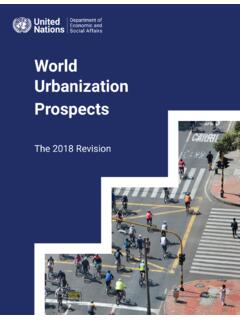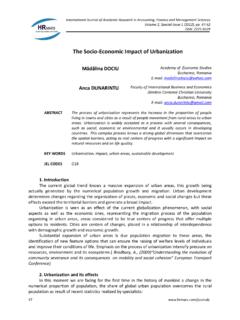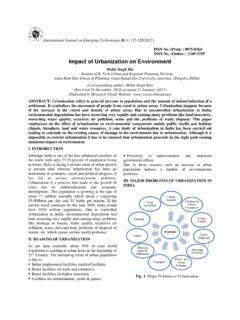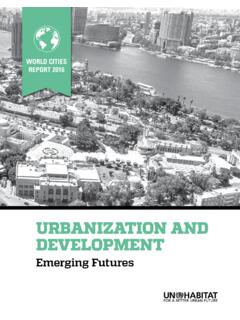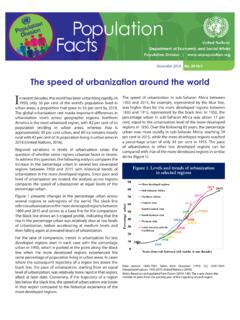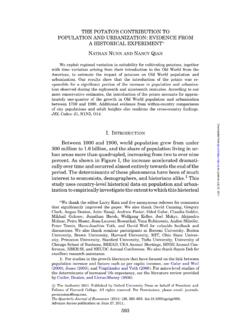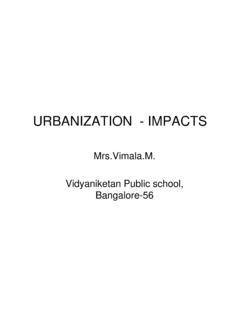Transcription of Policies on Spatial Distribution and Urbanization
1 Policies on Spatial Distribution and Urbanization Data Booklet United Nations Policies on Spatial Distribution and Urbanization The Spatial Distribution of the population and Urbanization are closely linked to developmental challenges and opportunities. More than half of the world s population already resides in urban areas, while the remaining rural population increasingly depends on urban centres for social and economic progress. Policies to improve living conditions of people in both rural and urban areas and to promote sustainable Urbanization are relevant for the implementation of the 2030 Agenda for Sustainable development and for the new framework for urban development adopted during the United Nations Conference on Housing and Sustainable Urban development (Habitat III) in October 2016 in Quito, Ecuador. This data booklet presents selected government Policies , strategies and measures to influence the Spatial Distribution of the population and to promote rural development and sustainable Urbanization for 197 countries.
2 Data are drawn primarily from the World Population Policies Database: The 2015 Revision. Suggested citation: United Nations, Department of Economic and Social Affairs, Population Division (2016). Policies on Spatial Distribution and Urbanization : Data Booklet (ST/ESA/ ). Cover photo: Copyright UN Photo/Ari Gaitanis 3 Policies on Spatial Distribution and Urbanization Percentage of population living in urban areas The proportion of the population residing in urban areas is rising in all regions of the world, but the rate of urban growth is much higher in Africa and Asia, where 85 per cent of the global increase in the urban population between 2015 and 2030 is projected to occur. During this period, the number of urban agglomerations with population of five million or more is projected to increase from 73 to 104. Of the additional 31 new urban agglomerations in this category, 26 will be in Africa and Asia. 2015 2030 The boundaries and names shown and the designations used on this map do not imply official endorsement or acceptance by the United Nations.
3 Dotted line represents approximately the Line of Control in Jammu and Kashmir agreed upon by India and Pakistan. The final status of Jammu and Kashmir has not yet been agreed upon by the parties. Chagos Archipelago/Diego Garcia - Appears without prejudice to the question of sovereignty. A dispute exists between the Governments of Argentina and the United Kingdom of Great Britain and Northern Ireland concerning sovereignty over the Falkland Islands (Malvinas). Final boundary between the Republic of the Sudan and the Republic of South Sudan has not yet been determined. Final status of the Abyei area is not yet determined. Data source: United Nations, Department of Economic and Social Affairs, Population Division (2014). World Urbanization Prospects: The 2014 Revision, CD-ROM Edition. 4 Policies on Spatial Distribution and Urbanization Governments with Policies or strategies in the past five years to encourage population redistribution, 2015 72 78 51 87 72 48 72 100 80 39 47 17 46 70 14 34 0 7 020406080100 WorldLessdevelopedregionsMoredevelopedre gionsAfricaAsiaEuropeLatinAmericaand theCaribbeanNorthernAmericaOceaniaReduce rural to urban migrationDecentralize large urban centres to smaller urban, suburban or rural areasPercentage of countries Governments in less developed regions were more likely than those in more developed regions to have adopted Policies or strategies in the past five years to influence the Spatial Distribution of the population in their countries.
4 Data source: United Nations, Department of Economic and Social Affairs, Population Division (2016). World Population Policies Database: The 2015 Revision. 5 Policies on Spatial Distribution and Urbanization Governments with Policies to reduce migration from rural areas to urban areas in the past five years, 2015 In recent years, countries experiencing higher urban growth rates, which are mostly in lower income groups, were more likely to have Policies to reduce migration from rural areas to urban areas. Adopted Policies to reduce migration from rural areas to urban areas: Yes No Bubble size is proportional to urban population 2014 Data sources: United Nations, Department of Economic and Social Affairs, Population Division (2016). World Population Policies Database: The 2015 Revision; United Nations, Department of Economic and Social Affairs, Population Division (2014). World Urbanization Prospects: The 2014 Revision, CD-ROM Edition; World Bank (2015).
5 World development Indicators 2015. Washington, DC: World Bank. 6 Policies on Spatial Distribution and Urbanization Governments with policy measures to promote rural development in the past five years, 2015 * Refers to five years preceding 2012 Despite increasing levels of Urbanization , measures to promote rural development were adopted by a large majority of Governments in all regions of the world. Policies to develop rural infrastructure and facilities remained nearly universal. 58 100 77 79 79 72 77 74 75 100 100 100 93 100 100 100 93 98 71 69 90 86 77 71 91 81 020406080100 OceaniaNorthern AmericaLatin America and the CaribbeanEuropeAsiaAfricaLess developed regionsMore developed regionsWorldIncentives to establish or retain industries in rural areasPolicies to develop rural infrastructure and facilitiesMeasures taken to promote rural development strategies to decrease push factors on Urbanization *Data sources: United Nations, Department of Economic and Social Affairs, Population Division (2016).
6 World Population Policies Database: The 2015 Revision; United Nations Population Fund (2012). The ICPD Beyond 2014 Global Survey Database. Percentage of countries 7 Policies on Spatial Distribution and Urbanization Governments with policy measures to increase energy efficiency in transport and housing in the past five years, 2015 High-income countries, where per capita CO2 emissions tend to be higher, were more likely to have adopted policy measures to increase energy efficiency in the transport and housing sectors in recent years. Many middle-income countries, but only a few low-income countries, had adopted such policy measures. Data sources: United Nations, Department of Economic and Social Affairs, Population Division (2016). World Population Policies Database: The 2015 Revision; International Energy Agency (2015). CO2 Emissions From Fuel Combustion Highlights (2015 Edition). Summary table CO2 emissions by sector in 2013 ; World Bank (2015). World development Indicators.
7 Washington, DC: World Bank. Yes No Bubble size is proportional to urban population 2013 Adopted Policies to increase energy efficiency in transport and housing: 8 Policies on Spatial Distribution and Urbanization 87 39 96 75 41 88 0 79 85 67 96 79 64 91 100 50 80 97 51 82 94 88 97 99 89 97 99 97 99 99 020406080100020406080100 LessdevelopedregionsMoredevelopedregions AfricaAsiaEuropeLatinAmericaand theCaribbeanNorthernAmericaOceaniaPolici es to secure access to water and sanitation for urban poorPolicies to secure land tenure and adequate housing for urban poorPercentage of urban population with access to improved sanitation facilitiesPercentage of urban population with access to improved water sourcePercentage of countries Percentage of urban population Governments with policy measures to improve living conditions of the urban poor in the past five years, 2015 Data sources.
8 United Nations, Department of Economic and Social Affairs, Population Division (2016). World Population Policies Database: The 2015 Revision; World Health Organization/United Nations Children s Fund (2015). Joint Monitoring Programme for Water Supply and Sanitation. Data and Estimates. In recent years, Governments in less developed regions were more likely to have adopted Policies to improve access to water and sanitation and to secure land tenure and adequate housing for the urban poor than in more developed regions, where access to such services was already widespread. 9 Policies on Spatial Distribution and Urbanization Data sources: United Nations Population Fund (2012). ICPD Beyond 2014 Global Survey Database; United Nations, Department of Economic and Social Affairs, Population Division (2014). World Urbanization Prospects: The 2014 Revision, CD-ROM Edition; United Nations (2015). Millennium development Goals Indicators. In less developed regions, concrete measures to improve living conditions of the urban poor were particularly lacking in countries with higher proportion of slum dwellers and faster pace of Urbanization .
9 Measures taken by Governments to ensure land, housing, services and livelihood of the urban poor in the past five years in less developed regions, 2012 Measures taken to ensure land, housing, services and livelihood of urban poor : Yes No Bubble size is proportional to urban population 2014 Policies on Spatial Distribution and Urbanization 10 Table 1 Government Policies , strategies and measures taken in the past five years to influence the Spatial Distribution of the population, promote rural development , and improve living conditions and sustainability of large urban centres Spatial Distribution of population Rural development Living conditions and sustainability of large urban centres Reduce migration from rural areas to urban areas Decentralize large urban centres to smaller urban, suburban or rural areas Relocate out of environmentally fragile or threatened areas Provide incentives to establish or retain industries in rural areas Relocate industries from large urban centres to rural areas Develop rural infrastructure and facilities Promote rural development strategies to decrease push factors on Urbanization Increase energy efficiency in transport and housing More stringent environmental regulations for industries within or surrounding large urban centres Improve solid waste management system Secure access to water and sanitation for urban poor Secure land tenure and adequate housing for urban poor Ensure land, housing.
10 Services and livelihood of urban poor 2015 2015 2015 2015 2015 2015 2012* 2015 2015 2015 2015 2015 2012* Africa Eastern Africa Burundi Comoros Djibouti Eritrea Ethiopia Kenya Madagascar Malawi Mauritius Mozambique Rwanda Seychelles Somalia South Sudan Uganda United Republic of Tanzania Zambia Zimbabwe Middle Africa Angola Cameroon Central African Republic Policies on Spatial Distribution and Urbanization 11 Spatial Distribution of population Rural development Living conditions and sustainability of large urban centres Reduce migration from rural areas to urban areas Decentralize large urban centres to smaller urban.










